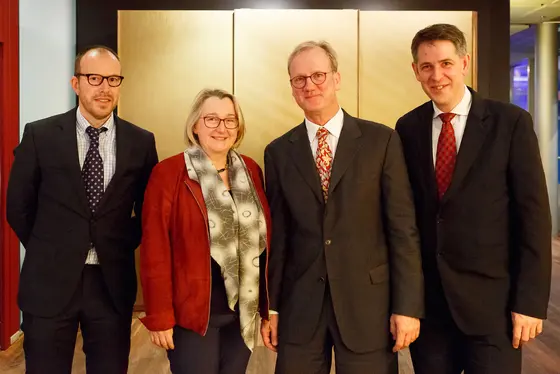“I am delighted that thanks to the Hopp Children's Tumor Center, the chances of recovery for severely ill children are being further improved. The Heidelberg University Hospital and the German Cancer Research Institute are continuing Heidelberg's success story in oncology,“ said Science Minister Theresia Bauer. Bauer went on to say that the fact that such fantastic projects like the KiTZ were initiated in Heidelberg, well-known for its medical research, confirms the high level of excellency as well as the great potential of local conditions – “and that we have set the right course in the past few years.“ Bauer said many thanks were due to those who made this project possible by their generous donations.
Clinic, Translation, Preclinic – the three pillars of the KiTZ
The goal of the KiTZ is to help children with cancer more effectively by using new diagnosis and therapy methods. “In the future, we would like to also give those children a chance for whom cancer returns or for whom there was previously barely a chance for recovery,“ said the directors of the KiTZ, the professors Andreas Kulozik, Olaf Witt, and Stefan Pfister during their opening speech. “The foundation for that is excellent and comprehensive care for our patients. Beyond that, we must expand our research – particularly in the preclinical and translational area.“
“Translation“ in medicine means the transfer of research results into clinical applications. And that is precisely what the main focus of the KiTZ will be. The opposite is just as important: taking observations from the clinic and applying them back to research. The KiTZ directors are confident: “With this focus we will be able to develop new diagnosis and therapy possibilities for patients with cancer recurrence.“
In order to improve the chances in child oncology, new concepts are essential. Even though four out of five children with cancer can be treated successfully ̶ for 20 percent there is currently hardly any chance of permanent recovery. Professor Dr. Michael Baumann, the chairman and science chair of the DKFZ stresses: “In order to give these children and their parents new hope, we need better diagnosis and therapy methods. We can only achieve this if we take the excellent child-specific cancer research in Heidelberg and apply it fully in the KiTZ.“
Clinic and research are growing together in the new KiTZ building
Just how important the convergence of clinic and research is, is shown by the joint decision by the Heidelberg University Hospital and the German Cancer Research Institute (DKFZ) to combine both in their own new building in the very near future. Both partners are doing this in order to make the cooperation of everyone involved in Heidelberg's child oncology much easier – something which will benefit the whole area. “The new KiTZ building will combine medical and scientific expertise in the field of child oncology and therefore strengthen Heidelberg's medical campus,“ said Professor Dr. Wolfgang Herzog, the dean of the medical faculty of Heidelberg. The new building will cost around 40 million Euros. The Dietmar Hopp Foundation is providing half of the sum, while another 10 million Euros are covered by other supporters. “We are looking for further donors for the remainder of the costs,“ said Herzog about the current funding gap of about 10 million Euros.
Symposium promotes networking amongst child oncologists
With a symposium taking place in the Print Media Academy Heidelberg on January 19 and 20 2017, the KiTZ wanted to promote the networking of researchers and clinicians at the highest level: At the “1st KiTZ Symposium on Pediatric Oncology and Hematology“ renowned speakers from across the world were presenting their research and medical applications in the field of child oncology on the topics of genomic and epigenomic research, tumor heterogeneity and resistance mechanisms, disease-models, precision oncology, hematology, immunotherapy and radiation therapy. Journalists are welcome to attend the symposium.
* The NCT was founded in Heidelberg in 2004 as the first “Comprehensive Cancer Center“ in Germany in cooperation with the German Cancer Research Center and Heidelberg University Hospital.



